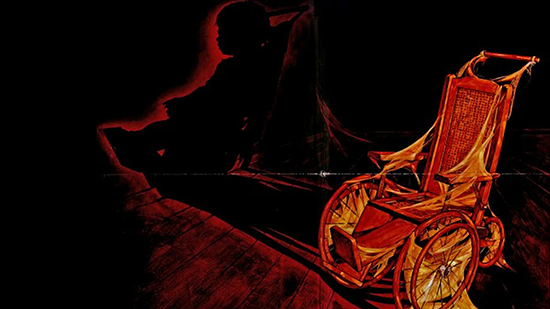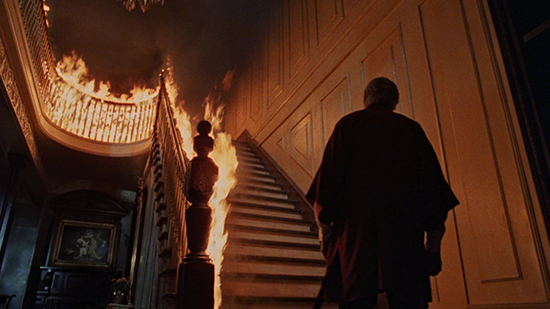“I knew about pain, a lot. And I knew about being frightened.” – Peter Medak
“This…” noted Roger Ebert, in his April 2nd review of Peter Medak’s The Changeling, “…is a scary movie with taste”. Whether you’re prone to agreement with one of the prominent film critics of the 20th century or not, Ebert is on the money here: The Changeling is a tasteful film. The camerawork is immaculate, soundtrack richly orchestrated, performances as understated and deliberate as the elegant, unfussy direction. In a year notable for the releases of Cannibal Holocaust, Maniac and Roger Corman’s nasty aquatic monster-fest Humanoids From the Deep, The Changeling stands out as a draft of an older, classier vintage, reminiscent of the creak of old leather and the smell of ancient tomes when compared with its contemporaries and their whack-a-mole approaches to crowd trauma. And Ebert was right about another thing as well. Despite this somewhat Victorian commitment to quality and standards, The Changeling is a fucking scary movie.
Re-watching the film for the purposes of this article – at a sunny 11.30am – I was again impressed by the white-knuckled dread inspired by this seemingly innocuous haunted house flick; the amount of times I would get that hot-between-the-ears glow one gets in the presence of an image or sequence that stands out as genuinely uncanny and frightening. The Changeling is devastatingly effective as a scare delivery system. But what makes it worthy of reappraisal – 40 years to the month after its original release – is what differentiates the film from the other haunted house stories that followed and preceded it. The Changeling is a film remembered four decades on because of its fascinating and at times contradictory impulses, its elegant restraint, and its suppurating air of desperate melancholy.
Director Peter Medak was an odd choice to helm a conventional horror film. Following his flight to the West from Budapest during the Hungarian uprising, he made his name with movies rooted in the counterculture of the late ’60s and early ’70s, such as his debut Negatives and his delightfully weird upper-class satire, The Ruling Class. What Medak, along with screenwriters William Gray and Diana Maddox, brought to The Changeling was a deep understanding of the sadness and horror of loss. Medak’s father had died in his arms after four years in a Soviet camp, he had lost his older brother when he was just 14, and his first wife had committed suicide while he was working on The Ruling Class. The Changeling, telling the story of a man haunted by the death of his family, owes a lot to its director’s stoical, unsentimental understanding of the power of grief.
Following the death of his wife and daughter in a freak accident, a music teacher and composer, John Russell (played with tectonic gravity by George C. Scott) rents an old house in order to write music and reflect. However, a series of disturbances and terrifying visions reveal that John is not alone in the turn-of-the-century pile, and an investigation into the house’s past reveals a conspiracy of lies and silence that penetrates into the upper echelons of government.
The Changeling’s set up is as old as the haunted house story itself. There’s a recent bereavement, an old house replete with pianos and chandeliers, and even a tinkling music box in the equation for anyone playing ‘Ghost Story Bingo’. But where Medak takes the story is unique. It twists and turns the outline of a basic haunting mystery until it transforms into an example of that other twilight staple – the conspiracy thriller.

A great deal of the film’s effectiveness comes from its clash of genres. The creaking gothic pile and nighttime disturbances of the traditional scare story and the furtive phone calls and cityscape offices of the conspiracy thriller are cosmetically very different, but both revolve around the core concepts of mystery and secrets, of characters searching for answers. This genre clash also keeps The Changeling cliché free. Unusually for a haunted house film, The Changeling is not a period piece, nor does it feel like one. Period scare stories, as exemplified by The Innocents and The Turn of the Screw, generally contain a sense of mounting hysteria. The protagonists are faced not only with spectral apparitions, but the fear that their own reasoning is revolting against them, with all the anguished self-examination that goes along with it. George C. Scott (General Patton himself!) is clearly the most rational man on the planet, so if he says a haunting is happening, then it’s happening. After his first terrifying glimpse of the ghost haunting his new home, he doesn’t go to pieces like any normal dweeb, but strolls briskly to the Historical Society building to get. some. answers.
Scott’s performance provides the lynchpin of The Changeling. He never overplays Russell’s emotional devastation, preferring to let telling moments clue the viewer in on his interior state. A grin that looks as if its been nailed to his face, particularly when being introduced to some new society friends early in the film, speaks more eloquently than any amount of hair tearing and weeping ever could. He carries himself through every scene like a piece of Mount Rushmore that got up and walked, with nothing but a barely perceptible downturn of his mouth reminding the audience of his loss.
Medak’s direction is just as quietly expressive. The camera sweeps through the rooms of the house like a child ballet dancer, his use of wide lenses trapping Scott in the empty studies and cavernous hallways of his new home. John Russell is completely and totally alone. Even an alliance with a worker at the Historical Society, played by Trish Van Devere, does little to assuage his solitary confinement. The snow-bound opening sequence, in which the lives of Russell’s wife and daughter are brutally and needlessly snuffed out, is shattering in its restraint. Scott can only watch, helplessly from inside a phone booth, as the two things most precious to him are taken away forever. There are no cries for help, no grief-stricken wailing and no music.
While The Changeling’s subtle genre subversion partly accounts for its success, its more traditional horror elements are effectively realised as well. Each appearance of the ghost is more chilling than the last, and the prolonged séance at the centre of the film is one of the practice’s best cinematic depictions. And tasteful the film may be, but its pivotal scene of a child’s murder is distressingly vivid. The overall presentation of the supernatural elements is especially unnerving; with the violent manifestations of the pre-pubescent ghost’s will becoming increasingly tantrum-like. When Russell, finally overcome with frustration at his pointless attempts to assuage the spectre’s needs, starts red-facedly screaming at it from the hallway, it could be an old man yelling at neighbouring kids for breaking his greenhouse window. George C. Scott, the craggy representation of all that is reasonable, is at the mercy of a supernatural child.
There are several interesting parallels between The Changeling and another subversive haunted house film released in 1980, Stanley Kubrick’s The Shining. Both were the products of directors not known for horror movies. The main characters in both films are artists – although one imagines John Russell does not get inspiration from lobbing a baseball around. George C. Scott was a Kubrick veteran, having played General ‘Buck’ Turgidson in Dr. Strangelove – he blamed his broad performance on a direction technique Kubrick also used on Jack Nicholson for The Shining, and so on. But the films can also be viewed as inversions of each other. In place of Kubrick’s sudden cuts and shocking blares of score, is a camera gliding around an old man playing a piano. Jack Nicholson’s rattling pressure cooker of a performance is contrasted by the regal bearing and leonine grace of George C. Scott. A father tormented by supernatural forces is driven to tear his family apart, while a broken man is compelled by a lonely ghost to bring one back together. Most importantly, where Kubrick’s emotional reserve permeates every frame of The Shining, Medak places us into the core of the deepest, most desperate sadness. Quiet The Changeling may be, but its emotional complexity and restrained horrors have given it a life long after many of its louder contemporaries have fallen by the wayside.


